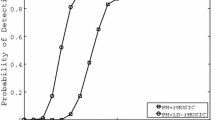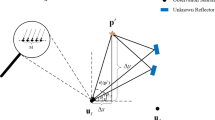Abstract
The Khatri-Rao (KR) subspace method is a high resolution method for direction-of-arrival (DOA) estimation. Combined with 2q level nested array, the KR subspace method can detect O(N 2q) sources with N sensors. However, the method cannot be applicable to Gaussian sources when q is equal to or greater than 2 since it needs to use 2q-th order cumulants. In this work, a novel approach is presented to conduct DOA estimation by constructing a fourth order difference co-array. Unlike the existing DOA estimation method based on the KR product and 2q level nested array, the proposed method only uses second order statistics, so it can be employed to Gaussian sources as well as non-Gaussian sources. By exploiting a four-level nested array with N elements, our method can also identify O(N 4) sources. In order to estimate the wideband signals, the proposed method is extended to the wideband scenarios. Simulation results demonstrate that, compared to the state of the art KR subspace based methods, the new method achieves higher resolution.
Similar content being viewed by others
References
KRIM H, VIBERG M. Two decades of array signal processing research: The parametric approach [J]. IEEE Signal Processing Magazine, 1996, 13(4): 67–94.
SHAN Zhi-yong, ZHOU Xi-lang, ZHANG Qi. A new method to estimate DOA in CDMA system in multi-path environment [J]. Journal of Central South University of Technology, 2006, 13(3): 270–274.
ZHENG J, KAVEH M, TSUJI H. Sparse spectral fitting for direction of arrival and power estimation [C]// IEEE/SP 15th Workshop on Statistical Signal Processing. Cardiff: IEEE Signal Processing Scociely 2009: 429–432.
HYDER M M and MAHATA K. Direction-of-arrival estimation using a mixed norm approximation [J]. IEEE Transactions on Signal Processing, 2010, 58(9): 4646–4655.
SCHMIDT R. Multiple emitter location and signal parameter estimation [J]. IEEE Transactions on Antennas and Propagation 1986, 34(3): 276–280.
YIN J, CHEN T. Direction-of-arrival estimation using a sparse representation of array covariance vectors [J]. IEEE Transactions on Signal Processing, 2011, 59(9): 4489–4493.
YANG Z, ZHANG C, XIE L. Robustly stable signal recovery in compressed sensing with structured matrix perturbation [J]. IEEE Transactions on Signal Processing, 2012, 60(9): 4658–4671.
ZHU H, LEUS G, GIANNAKIS G B. Sparsity-cognizant total least-squares for perturbed compressive sampling [J]. IEEE Transactions on Signal Processing, 2011, 59(5): 2002–2016.
BLANCO L, NÁJAR M. Sparse covariance fitting for direction of arrival estimation [J]. EURASIP Journal on Advances in Signal Processing, 2012, 2012(1): 1–11.
NORTHARDT E, BILIK I, ABRAMOVICH Y. Spatial compressive sensing for direction-of-arrival estimation with bias mitigation via expected likelihood [J]. IEEE Transactions on Signal Processing, 2013, 61(5): 1183–1195.
VAN TREES H L. Optimum array processing: Part IV of Detection, Estimation and Modulation Theory [M]. New York: Wiley Intersci, 2002: 178–191.
CHEVALIER P, FERRÉOL A, ALBERA L. High-resolution direction finding from higher order statistics: The 2q-MUSIC Algorithm [J]. IEEE Transactions on Signal Processing, 2006, 54(8): 2986–2997.
PAL P, VAIDYANATHAN P. Nested arrays in two dimensions. Part I: Geometrical Considerations [J]. IEEE Transactions on Signal Processing, 2012, 60(9): 4694–4705.
PAL P, VAIDYANATHAN P. Nested arrays: A novel approach to array processing with enhanced degrees of freedom [J]. IEEE Transactions on Signal Processing, 2010, 58(8): 4167–4181.
MA W K, HSIEH T H, CHI C Y. DOA estimation of quasi-stationary signals with less sensors than sources and unknown spatial noise covariance: A Khatri-Rao subspace approach [J]. IEEE Transactions on Signal Processing, 2010, 58(4): 2168–2180.
PAL P, VAIDYANATHAN P. Multiple level nested array: An efficient geometry for 2qth order cumulant based array processing [J]. IEEE Transactions on Signal Processing, 2011, 60(3): 1253–1269.
SHAN T J, WAX M, KAILATH T. On spatial smoothing for direction-of-arrival estimation of coherent signals [J]. IEEE Transactions on Acoustics, Speech and Signal Processing, 1985, 33(4): 806–811.
WANG H, KAVEH M. (CSSM) Coherent signal-subspace processing for the detection and estimation of angles of arrival of multiple wide-band sources [J]. IEEE Transactions on Acoustics, Speech and Signal Processing, 1985, 33(4): 823–831.
YOON Y S, KAPLAN L M, MCCLELLAN J H. TOPS: New DOA estimator for wideband signals [J]. IEEE Transactions on Signal Processing, 2006, 54(6): 1977–1989.
COHEN J. Statistical power analysis for the behavioral sciences [M]. New Jersey: Lawrence Erlbaum, 1988: 273–406.
STOICA P, GERSHMAN A B. Maximum-likelihood DOA estimation by data-supported grid search [J]. IEEE Signal Processing Letters, 1999, 6(10): 273–275.
Author information
Authors and Affiliations
Corresponding author
Additional information
Foundation item: Project(2010ZX03006-004) supported by the National Science and Technology Major Program of China; Project(YYYJ-1113) supported by the Knowledge Innovation Program of the Chinese Academy of Sciences; Project(2011CB302901) supported by the National Basic Research Program of China
Rights and permissions
About this article
Cite this article
Li, S., He, W., Yang, Xg. et al. Direction-of-arrival estimation of quasi-stationary signals using two-level Khatri-Rao subspace and four-level nested array. J. Cent. South Univ. 21, 2743–2750 (2014). https://doi.org/10.1007/s11771-014-2236-5
Received:
Accepted:
Published:
Issue Date:
DOI: https://doi.org/10.1007/s11771-014-2236-5




